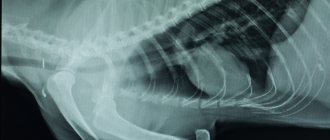A fish bone stuck in your throat - why is it dangerous?
1. During the meal, you cannot laugh or communicate without chewing the food.
A bone in the throat causes tingling, burning and heavy breathing. Before you get rid of it, study the consequences of independently removing a foreign body at home. 2. As a rule, the bone remains in the area of the lateral ridges, tonsils or tongue. If manipulations are carried out incorrectly, a foreign object gets stuck and contributes to irritation of soft tissues.
3. It’s extremely rare, but it still happens; the bone contributes to breathing problems. It can cause choking, swelling or severe cramping.
4. If the bone moves towards the esophagus, there is a risk of esophagitis. Symptoms of the disease include fever, pain when swallowing, vomiting with blood, excessive salivation, and unpleasant squeezing behind the chest.
5. When a person has a fish bone stuck in their throat and these signs appear, you cannot put off going to the ENT specialist. The specialist knows what to do. It has all the tools you don't have at home to safely remove a foreign body.
6. If you refuse timely intervention from a doctor, you risk encountering purulent processes that will lead to an increased release of toxins into the blood. In advanced stages, surgery is indispensable to prevent death.
What causes bones to get stuck in the throat?
There are several common reasons as a result of which the phraseological phrase “like a bone in the throat” turns into a real dangerous situation:
- Prolonged hunger . If a cat has not received food for a long time, it can literally attack the food, swallowing large pieces without chewing. In this case, there is a high risk that the animal will choke.
- Eating from someone else's bowl . Almost all mustachioed striped animals have a reputation for being very arrogant and unprincipled individuals who are not averse to eating from dog cups. Moreover, particularly shameless individuals may not even allow the owner to approach the bowl until they themselves “taste the dishes.” And if dogs can eat large bones without any problems, then cats may not be able to handle such food.
- Eating a whole fish . Responsible and experienced cat owners know that these pets can only be given boiled fish, previously deboned. But often whole fish, raw, are included in the diet of domestic cats. Not only can such a “delicacy” be infected with helminths, but also sharp fish bones often dig into the delicate mucous membrane of the throat, getting stuck in it or penetrating further into the esophagus and fixing there.
- Picking up street trash. This is a common problem for cats accustomed to free-ranging outside. Here they can eat any, including dangerous, objects that are not always edible.
How to keep your cat safe. The owner should monitor his pet more closely and avoid the presence of:
- duck bones;
- bones of large fish of fatty varieties: silver carp, pike, Siberian roach;
- fish tail bones, heads, as well as gills and gill covers.
If, despite all the preventive measures, a bone still gets stuck in the cat’s throat, then the owner will definitely notice warning signs.
This is interesting: Albumin levels for cats
How does a pet behave if it chokes on some food?
Typically, an animal will get into trouble if its diet contains food that contains hard or semi-solid parts, such as bones. Veterinarians do not recommend giving cats this food. It is better to feed them only soft parts of fish or meat. You can't rely on your pet's teeth.
The first priority for a person is to identify symptoms that indicate that a kitten or adult animal is choking. To do this, you need to take a closer look at your pet. If he chokes on, for example, a fish bone, the following symptoms usually appear:
- The presence of a hard object in your pet's throat is indicated by the urge to vomit. If the bone is stuck deep, then the cat’s attempts to remove the bone by vomiting will increase, but they will not bring success.
- Usually in this state he cannot swallow small pieces of food or drink water. Panicking cat can't swallow his own saliva.
- Signs of vomiting may not appear, but severe vomiting may begin. If its intensity is high from the very beginning, it means that the animal actually choked on a solid piece of food.
Sometimes the owner just thinks that something has happened to his pet. Usually a person is mistaken if a cat begins to tremble, has convulsions, opens its mouth, and coughs. It may just be a wave-like cough, which makes it clear that there is trouble in the pet’s respiratory system.
Therefore, a person must be able to distinguish these symptoms from vomiting that appears in a pet when a bone gets into the throat.
Some cats, quite rarely, have an abnormal throat structure that can cause symptoms similar to choking on a hard object. The same urges (vomiting, choking) appear in cats with an allergic lesion, but other symptoms should also arise.
If the owner knows that before signs of trouble appeared the animal ate bones, then most often they cause vomiting if they fail to pass through the pet’s throat. Therefore, a person must act quickly.
- First, a choking cat is checked to ensure adequate breathing. If she breathes freely enough, it means the foreign body is shallow. A person can try to get it out with tweezers. It will not be easy for one owner to do this; an assistant will be needed, since an animal panicking due to fear of suffocation will scratch, twist, and run away from people.
Therefore, the assistant must hold the pet tightly and bring it to a bright light source. The owner of the pet opens the cat's mouth and, if the tip of the bone is visible, tries to grab it with tweezers and then remove it from the pet's throat.
- There is another way to fix the problem. You need to pour a little vegetable oil into the mouth. It will force the bone into the animal’s stomach and help it put its respiratory system in order.
- Owners who have experience with cats recommend in such situations to lower the pet upside down (as mothers do with their children if the child is choking), and then hit the cat hard on the chest or slap it on the back. This will help shake the bone out of your throat.
- You can try to artificially induce vomiting. Then the pet's throat will contract and push the bone out. You need to act quickly, but do not use force, as this will cause stress in the cat.
Kittens often choke due to the speed of eating food. If this happens, the baby is picked up and warm water is poured into his mouth. You can lightly pat your pet on the back with your palm.
It is forbidden to give your pet vodka or alcohol, or laxatives. Sometimes surgery may be necessary.
So, if you know that the cat has eaten bones, and she definitely choked, do not panic, but act quickly and correctly. First of all, determine the adequacy of breathing, and if everything is fine with it, the foreign object is not deeply stuck, then you can try to pull it out with tweezers. Of course, it will be difficult to do this alone, because the cat will wriggle out, scratch, and run away.
But by enlisting the support of one of the family members, bringing the animal to a source of bright light, you can try to get the bone. The second option for help is vegetable oil. You just need to pour it down your throat in at least a teaspoon. It will make it easier for the injured cat to breathe and will help the foreign body slide.
Experienced pet owners act differently in such situations. Some lower the cat upside down, like a child, and slap it hard on the back, on its chest. That is, we are talking about tapping or shaking out the bone from the throat. Others try to induce vomiting so that the throat contracts and pushes the bone out.
Experience shows that kittens often choke on food when they eat it quickly. This happens when there are several of them, and everyone is trying to grab more for themselves (the struggle for survival), but the throat simply cannot cope with such a load. In such a situation, you need to take the baby and pour warm water into his mouth or pat him on the back with your palm.
In rare cases, bone suffocation can lead to tragic consequences. If you see that your pet’s tongue is turning blue, you need emergency help from a specialist. In such cases, you should always have the veterinarian’s phone number at hand. If the cat is breathing normally, but periodically gags, trying to get rid of a foreign object, immediately take him to the veterinary clinic.
Sometimes, to remove a foreign body from a cat’s pharynx or esophagus, it is impossible to do without general anesthesia. It is very rare that bones are removed from the stomach surgically or endoscopically. This is an exception to the rule, but the owner must be prepared for such an outcome.
If you are afraid to help yourself and don’t know what to do, your dog has a bone stuck in its intestines, contact your veterinarian.
Let's consider some points:
- If bone fragments are stuck in the mouth, you can try to remove them yourself. Fix the dog in one position, use a mouth expander. If the fragment is visible, remove it with tweezers. If it is impossible to see the location of the fragment, you can illuminate the mouth with a flashlight. After release, sprinkle a weak solution of potassium manganese into the oral cavity;
- If the dog has severe chills that were caused by convulsive processes, no-shpa should be administered to remove contractions of the smooth muscles. This will help the fragment move further along the digestive tract;
- To get rid of painful spasmodic sensations in the smooth muscles of the gastrointestinal tract, you need to give your pet an injection, either Apomorphine or Papaverine;
- If the dog has food failure, in this case it is forbidden to feed the dog laxatives or antiemetics;
- The Heimlich method. In a situation where a pet has a bone fragment stuck in its esophagus, there is no need to think twice, you need to help it. Veterinarians suggest using the Heimlich method. It helps move and push bones out of the animal's esophagus.
We suggest you read: Is it possible to give chicken necks to cats? How to give chicken bones
Let's consider this process:
- Place your pet on all fours;
- Grasp it with both hands in the abdominal area;
- Firmly clench your fist on your right hand and press your sternum with your thumb;
- Weave a kind of “lock” with your hands, that is, press the fist of your right hand on top with your left hand;
- Press sharply on the animal's diaphragm a couple of times. Make four or five such movements strictly from bottom to top. This will help remove bone fragments.
If the animal is small, then such manipulations should be done more carefully, with little effort. Pressure must be applied only with the fist of the right hand. A small dog must be lowered with its muzzle down, while pressing its back against your chest. Small fragments cannot be removed this way.
The Heimlich method must be used with great care. If you incorrectly calculate the force applied, you can only harm your pet. And many dogs can react differently to such a procedure. If you don’t know what to do if your dog has a bone stuck in its intestines, then you shouldn’t use the Heimlich method yourself.
If bone fragments are stuck in the gastrointestinal tract, you should not experiment or help your dog using home remedies. For example, if the stomach is perforated, the animal may face a severe inflammatory process; prolonged irritation of the intestine with bone fragments can lead to infection and necrosis.
If your cat has a fish bone stuck
Despite the fact that the cat's jaw and mucous membranes are adapted to eating and chewing even large fish bones, there are times when the bone gets stuck in the throat. This is why veterinarians do not recommend giving domestic cats heads and tails from fish, as well as vertebral bones. They are the ones that most often get stuck in a cat's throat.
If such a problem arises, the animal will refuse to eat, cough, and try to pull out the foreign body with its paw. There is also regular gagging and excessive salivation.
In this case, you need to contact the nearest veterinary clinic. Specialists will help remove the bone from the throat and prescribe treatment if necessary.
Why cats can have big bones
If a fish bone is stuck, determine its location in the throat and understand what to do. It is necessary to select a suitable method at home taking into account the location.
No. 1. Soft food
To minimize the likelihood of injury to the mucous membranes and move the bone into the stomach for successful digestion, you need to enclose it in a “cocoon”. Foods with an enveloping effect, such as jarred cottage cheese or non-drinkable yogurt, can do the trick. Alternatively, eat thick puree, mashed banana, marshmallows or marshmallows.
No. 2. Bread crumb
An ancient method that is used by everyone without exception. Take not today's bread, but yesterday's bread. The soft part should serve as a kind of “pillow” into which the bone will be embedded. Tear off a piece and swallow whole. If it doesn't help right away, repeat.
No. 3. Beverages
If the bone is not deeply embedded in the soft tissues, then you can try to wash it off. For this purpose, any thick drinks are consumed: jelly, drinking yogurt, fermented baked milk, homemade kefir, thick juice with pulp.
No. 4. Honey and butter
If you get a fish bone stuck in your throat, don't panic. What to do: drink a small amount of oil. This will allow the bone to move further. As an alternative at home, soak the bread pulp in a mixture of liquid honey and olive oil. The components are mixed in equal quantities. Eat a piece of bread.
No. 5. Paraffin
This option is not the safest and must be used with extreme caution. It can be used if the bone is visible and it is not deep. Use a long candle and light the wick. Paraffin should collect around it. Put out the candle and carefully insert it into your throat. Use the soft end to hook the bone. Wait a bit for the paraffin to harden. Take out the candle.
No. 6. Gauze cloth
When you have a fish bone stuck in your throat, use a clever method. What to do: Wrap a small piece of gauze around your finger. Swipe over the area where the bone is stuck. It should catch on the fabric. Gently remove your finger.
Unlike other animals, in their oral cavity there is a special hyoid bone, which allows them to fix the tongue, muscles of the oral cavity or larynx. The mucous membranes are insensitive to fish bones, so a cat can confidently chew a bone even from a fish without injuring the mucous membranes, although it is better not to give them large and hard bones, especially a fish spine or tail.
The cat scratched its throat with a bone - what to do?
A bone doesn't always get stuck in a cat's throat. Passing into the esophagus, it can simply scratch the mucous membrane. The animal's behavior and symptoms are often similar to those of a bone stuck in the throat.
Only a specialist can make an accurate diagnosis. Even if the owner, opening the animal’s mouth wide, does not see the bone, this does not mean that it is not there. Only a veterinarian can accurately determine that the throat is scratched.
If he scratches his throat and doesn’t eat, what should I do? In this case, the animal may refuse food for a short period. The veterinarian may prescribe a throat treatment with furatsilin solution.
This can be done at home or visit a clinic. During the healing period, you can offer your pet soft food in the form of porridge, boiled rice, thick soup or soft food. The scratch does not bother the cat for long, and in a day or two the animal will begin to eat normally.
Features of the pharynx and esophagus in cats
Cats can chew and digest large amounts of food in one sitting.
The food consumed by the animal enters the oral cavity, the base of which are two jaws - the lower and upper jaws, the bones of the palate and the incisive bone.
Inside the oral cavity there is also a hyoid bone, which anchors the lingual, pharyngeal and laryngeal muscles. In this case, the oral cavity begins from the lips, extends through the pharynx and then makes a smooth transition into the pharynx.
Digestion begins directly in the oral cavity through the mechanical action of the teeth - chewing. Simply put, a cat's digestive system consists of the mouth, the pharynx, the esophagus, the stomach, the small intestine, the large intestine, and ends in the rectum and anus.
Cats and cats can chew and digest a fairly large amount of food in one sitting, while powerful teeth can even gnaw bones. However, it happens that this same bone gets stuck at a certain interval and the animal cannot cope with the problem on its own.
Signs of a foreign object in a pet's throat are easy to recognize. These symptoms include:
- signs of suffocation - difficulty breathing;
- persistent suffocating cough;
- profuse drooling;
- urge to vomit;
- the pet's attempts to fix the problem.
A choking cough is a sign that the cat is choking.
If your pet has difficulty breathing, you should pay attention to the color of his gums. Lack of air will appear on the mucous membrane of the gums with a bluish color and it is necessary to immediately take measures to save the animal. Normally, the gums should be pink.
If a chicken bone is stuck
This is the most dangerous type of bone. In nature, cats often catch birds and eat them. Their jaws are capable of crunching hard bones and swallowing them. A domestic cat cannot always cope with such food. Therefore, many veterinarians do not recommend giving chicken bones to pets. Their fragments can get stuck in the throat or scratch it.
If a chicken bone gets stuck in a cat's throat, the animal will exhibit all the signs described above. To remove this residue from the throat, you must contact a veterinary clinic. The specialist will remove the bone from the throat and give recommendations on proper nutrition for the cat.
The difference between a normal physiological process and the presence of a foreign object
You need to be aware of the differences between the signs of a foreign object and a normal physiological process.
- A cat may experience rapid or difficult breathing when trying to regurgitate a hairball stuck in the esophagus or stomach.
- At the same time, the cat tenses up, may arch over, and cough forcefully.
- Such symptoms can easily be confused with vomiting and asthma attacks.
A cat may experience difficulty breathing when trying to regurgitate a hairball.
False suffocation
The problem of false suffocation is eliminated by gentle stroking.
It is also necessary to remember what your pet ate. It is quite possible that false asphyxiation could occur.
This happens if your pet inhales too deeply and can pull the soft palate into the larynx.
The convulsive breaths that the cat makes only move the palate closer to the windpipe. The problem can be eliminated by gentle stroking or it is necessary to give the cat something to eat so that the swallowing reflex removes the dangerous symptom.
Symptoms and signs.
You can identify the problem by some of the symptoms and signs that the animal exhibits.
- The animal may cough constantly. This will continue until the bone comes out.
- The cat is breathing frequently and heavily. This symptom may also indicate other diseases, but if the pet ate fish or meat the day before, the cause may well be a bone.
- Vomiting. The cat will try to regurgitate the bone. Constant gagging indicates a stuck bone.
- Profuse salivation. The drool may hang directly from the mouth without the cat's mouth being tightly closed.
- The animal tries to pull out the bone on its own. In this case, the cat can move its paw along its face, as if trying to pull out a bone.
How to tell if a cat is choking
Look closely at your coughing pet and remember what he has been doing lately. If the cat had previously been sleeping peacefully or slowly walking around the apartment, and then suddenly began coughing, then it is unlikely that she could have choked on something. Since she wasn't trying to eat anything, there was nothing to get stuck in her respiratory tract.
Sometimes the cause of suffocation is the pulling of part of the soft palate into the larynx. The animal begins to worry and the following breaths in the same way attract the soft palate to the windpipe. To eliminate the trouble, just calm your pet down by talking gently to him and petting him. In some cases, normal swallowing helps, and the soft palate becomes in the correct position. Offer your pet something tasty to eat and she will swallow it.
If a bone is stuck in a cat's throat, this is noticeable in its behavior. Characteristic signs of the presence of a foreign body in the esophagus are:
- Refusal to eat. If the animal immediately stops eating and refuses its favorite foods for a long time, be wary. This is one of the signs that a bone is stuck in the throat;
- Signs of suffocation and difficult, rapid breathing;
- The cat tries to pull the foreign object out of its mouth on its own, makes characteristic movements or tries to get its paw into its mouth;
- Copious flow of saliva;
- Choking cough that does not go away;
- gagging or vomiting.
We suggest you read: A dog has diarrhea and vomiting: what to do, with blood, actions
First aid
The larynx of cats is highly sensitive. In the event of a spasm, the respiratory system is blocked, resulting in suffocation. If your cat chokes on a fish bone, something should be done immediately.
First aid:
Immobilize your pet by wrapping it in a towel or other thick cloth. You only need to leave your head outside. It’s great if one person holds the cat, and the second one takes the foreign object out of the mouth. Examine your cat's mouth. To do this, move her head back a little, press her lower jaw with your finger to open her mouth. If the bone is clearly visible, then pull it out with tweezers (you cannot put your fingers into the mouth, as there is a possibility of pushing the foreign object even deeper). A deeply stuck bone that is difficult to see and cannot be removed
Therefore, it is better not to try to do this, as there will be more harm than good. Try to dislodge the stuck object by firmly and at the same time gently tapping it between the cat's shoulder blades with the palm of your hand. To do everything correctly, you will need to place your pet on the floor, with its muzzle away from you, with its hind limbs held between your knees.
Place your palms on both sides of the cat's chest and squeeze it four to five times, approximately 1/3 of the way, with quick jerks. This is done so that the pet begins to cough and can thus push out a foreign object. You cannot press too hard, as there is a danger of breaking the animal’s ribs. If the cat is unconscious (which can happen as a result of asphyxia), then you need to act differently. Open your pet's mouth as wide as possible and look for the stuck object; if you can see it, remove it with tweezers.
shutterstock
Remove any liquid that has accumulated in the cat’s mouth using a clean rag or napkin (cotton wool cannot be used, as it consists of fibers that can stick to the surface of the mouth and aggravate the situation).
A veterinarian should examine a cat that has previously choked, since it would be useful for its owner to know how severely the respiratory organs are injured and whether treatment is required. This is if the stuck object was removed
It is important that your pet is calm before being examined by a doctor.
If it was not possible to clear the cat’s airways on your own, you must immediately contact a veterinarian. Before leaving, you should notify the doctor about your visit and ensure that your pet is transported as comfortably as possible.
What to do if a bone is stuck in your throat: first aid, treatment methods, reviews
If your cat eats fish and chokes, don't panic. Sharp and hasty actions can provoke a laryngeal spasm, which can lead to suffocation. Before you do anything, you need to take the following steps:
- Wrap the cat in thick cloth, just so that the head sticks out;
- Apply gentle pressure to the lower jaw and examine the oral cavity. If a fish bone is stuck between your teeth, carefully remove it with tweezers. It is better if one family member holds the cat between his knees while the other removes the bone. Under no circumstances should this be done with your fingers or hand;
- If the foreign object is far away and not visible, hit the cat between the shoulder blades;
- You need to sit on the floor, turn the animal’s head away from you and rhythmically press with your hands on both sides, which will provoke a cough. The cat's bone will come out on its own;
- If the cat is not conscious, then you need to open its mouth wide and carefully remove the bone with tweezers;
- Then you need to tilt the cat head down and use a damp cloth to remove excess liquid;
- After cleaning the oral cavity, artificial respiration should be given to the cat through the nose;
- If an object is stuck in a cat’s throat, if it is sharp and located very deep, you should not remove it yourself if the animal is conscious. You can damage the mucous membrane and cause injury and suppuration;
- If your cat vomits, the bone may come out with it. Especially if she's stuck nearby. But if you feel that you cannot cope with the problem on your own, the cat will need the help of a specialist who will remove the bone;
- If an animal has swallowed petroleum products, acid or a sharp object, it is impossible to induce vomiting. You can remove a bone from a cat by giving it a few tablespoons of vegetable oil, but if you cannot see the object or it is deep, contact a specialist.
Many owners make a big mistake by letting their pets chew on bones. Before making such mistakes, it is worth knowing the structure of the cat’s digestive system, in particular the pharynx and esophagus.
If it was not possible to remove the object, you must urgently take the cat to the clinic.
If the efforts made do not bring results, and it was not possible to remove the foreign object, you must urgently call a veterinarian or take the animal to the clinic, having first reported the problem to the doctor. It is necessary to transport your pet in the most comfortable conditions. Provide adequate access to fresh air. In a hospital setting, the doctor may inject the cat with an anesthetic for a more thorough examination and procedure.
For some reason, when talking about a bone in a person’s throat, a fish bone immediately comes to mind. However, a bone fragment from a chicken or a fragment of part of the skeleton of a pig or cow can also cause trouble. By the way, such fragments are easier to remove, but they lead to more severe injuries, since they are larger, sharper, and violate the integrity of blood vessels.
But most often you still have to get a fish bone, a sharp fragment of which is embedded in the mucosa.
What to do when a fish bone is stuck in your throat?
It is advisable to examine the throat to determine where it is stuck. In some cases, there is no need to remove anything - the bone has already slipped through, and the sensation of a foreign body is caused by a scratch.
An examination of the throat is carried out as follows - you need to open your mouth wide in front of the mirror and point a flashlight there. There is no flashlight; you can carefully hold a lit match in front of your open mouth. If the bone is visible, you can pull it out with ordinary tweezers from a manicure set - just pre-treat it with an antiseptic.
It is much more difficult to solve the problem of how to remove a bone from a child’s throat, even if it is visible. It is unlikely that the child will sit quietly and allow him to pick in his mouth. It is better to seek medical help immediately. If you apply force, the baby can be seriously injured.
The bone is small, you can feel it, but you can’t see it. You need to make an antiseptic solution and rinse your nasopharynx vigorously. The possibility of an inflammatory process due to the use of an antiseptic is reduced, and vigorous contractions of the laryngeal muscles promote the release of the bone.
In an adult, you can try to remove a foreign body with your fingers - first you need to wash your hands thoroughly. An adult can try to do these manipulations himself - if the emetic effect is not pronounced. Some advise lubricating the larynx with lidocaine, but this is not recommended for self-manipulation - the anesthetic reduces sensitivity, and it is unlikely that you will be able to determine the location of the foreign body yourself.
You should not try to remove a foreign object with a toothbrush. There is no guarantee that a thin fish bone will get between the bristles and jump out; it can be “drowned” even deeper and the painful sensations will intensify.
Folk remedies that help get rid of the problem are presented in a wide range.
- Eating products with a viscous consistency - yogurt, thick kefir, mashed potatoes, viscous porridge. The effect of such products is enveloping. They pass through the esophagus slowly, “pulling” the bone along with them, giving it the opportunity to pass into the stomach, but without damaging it, since they enclose this foreign body in a dense cocoon. Even if the cocoon does not work out, mucous foods create a protective layer in the stomach and the likelihood of damage to it is reduced;
- Many people recommend finely chewing and swallowing the crust of black bread - you can also use regular bread. The likelihood that the chewed crust, passing through the larynx, will catch a foreign body is high. However, there is no guarantee that the bone will not get stuck below or in the gastric mucosa;
- A method in which the seed is promoted using liquid honey is considered effective. Honey has a triple effect - it is viscous in consistency, protects the mucous membrane of the larynx and digestive organs from damage, and has an antiseptic effect. This reduces the likelihood of an inflammatory process and further suppuration;
- Using melted paraffin or stearin to extract bone is quite problematic, although such a recipe exists. A hot substance can cause a burn to the mouth or larynx, and after cooling, these products coagulate and can no longer catch a foreign object. In addition, paraffin and stearin are inedible, so they are placed under the pit only if it is visible.
A rescue operation using paraffin or stearin is carried out as follows:
- the throat is examined;
- near a candle – long enough – the wick is lit;
- allow the melting product to accumulate in the recess near the wick;
- insert the extinguished candle into the throat and try to pick up the bone with soft paraffin (or stearin).
Under no circumstances should you stick your fingers or other auxiliary objects deep in order to pull a fish bone out of the throat. These actions can aggravate the victim's condition.
The method of letting the victim smell something sharp so that he sneezes is also questionable. Active muscle contractions do not always cause foreign body rejection. And where is the guarantee that the bone will fall into the oral cavity and be spat out? It can move further and enter the esophagus, and even the trachea, blocking breathing. It is especially dangerous to do this if the bone is stuck in the child’s throat.
If you managed to get rid of the foreign body, you need to immediately carry out anti-inflammatory prophylaxis - rinse the nasopharynx with antiseptic solutions.
This needs to be done for another 2-3 days, no less, until the mucous membrane has completely healed. When you cannot cope with the problem on your own, you need to seek medical help. A bone in the throat is not just discomfort; trauma to the mucous membrane is a gateway to infection.
The inflammatory process can cause suppuration in the surrounding tissues and disrupt the function of speech and breathing.
To avoid unpleasant situations - bones and other sharp objects do not get stuck in the mucous membrane of the throat - it is necessary to remember the folk wisdom: “When I eat, I am deaf and dumb” - that is, do not be distracted from eating.
We suggest you read: What to do if your cat’s water breaks and how long will it take for her to give birth?
From childhood, children must be taught the culture of eating:
- do not put large pieces in your mouth;
- use cutlery;
- do not chat while eating and do not play.
Adults cannot always take advantage of these tips, even when eating fish dishes. Many business and friendly meetings take place around the table.
If you chew your food thoroughly and do not bite off huge pieces, then the possibility of a foreign body entering the esophagus will be reduced to a minimum.
Useful materials:
- Cutaneous horn General description of the disease Cutaneous horn on the forehead or face (ICD 10 code - L57.0) -...
- Itching and odorless discharge Main causesBefore considering the factors that provoke the appearance of discharge that has a sour odor, it is necessary to immediately note...
- Discharge in women What kind of discharge between menstruation is considered normal? Female discharge normally consists of mucus from the cervical canal, dead...
The larynx of cats is highly sensitive. In the event of a spasm, the respiratory system is blocked, resulting in suffocation. If your cat chokes on a fish bone, something should be done immediately.
First aid:
- Immobilize your pet by wrapping it in a towel or other thick cloth. You only need to leave your head outside. It’s great if one person holds the cat, and the second one takes the foreign object out of the mouth.
- Examine your cat's mouth. To do this, move her head back a little, press her lower jaw with your finger to open her mouth. If the bone is clearly visible, then pull it out with tweezers (you cannot put your fingers into the mouth, as there is a possibility of pushing the foreign object even deeper). A deeply stuck bone that is difficult to see cannot be removed. Therefore, it is better not to try to do this, as there will be more harm than good.
- Try to dislodge the stuck object by firmly and at the same time gently tapping it between the cat's shoulder blades with the palm of your hand. To do everything correctly, you will need to place your pet on the floor, with its muzzle away from you, with its hind limbs held between your knees. Place your palms on both sides of the cat's chest and squeeze it four to five times, approximately 1/3 of the way, with quick jerks. This is done so that the pet begins to cough and can thus push out a foreign object. You cannot press too hard, as there is a danger of breaking the animal’s ribs.
- If the cat is unconscious (which can happen as a result of asphyxia), then you need to act differently. Open your pet's mouth as wide as possible and look for the stuck object; if you can see it, remove it with tweezers.
First aid
If your cat eats fish and chokes, don't panic. Sharp and hasty actions can provoke a laryngeal spasm, which can lead to suffocation. Before you do anything, you need to take the following steps:
- Wrap the cat in thick cloth, just so that the head sticks out;
- Apply gentle pressure to the lower jaw and examine the oral cavity. If a fish bone is stuck between your teeth, carefully remove it with tweezers. It is better if one family member holds the cat between his knees while the other removes the bone. Under no circumstances should this be done with your fingers or hand;
- If the foreign object is far away and not visible, hit the cat between the shoulder blades;
- You need to sit on the floor, turn the animal’s head away from you and rhythmically press with your hands on both sides, which will provoke a cough. The cat's bone will come out on its own;
- If the cat is not conscious, then you need to open its mouth wide and carefully remove the bone with tweezers;
- Then you need to tilt the cat head down and use a damp cloth to remove excess liquid;
- After cleaning the oral cavity, artificial respiration should be given to the cat through the nose;
- If an object is stuck in a cat’s throat, if it is sharp and located very deep, you should not remove it yourself if the animal is conscious. You can damage the mucous membrane and cause injury and suppuration;
- If your cat vomits, the bone may come out with it. Especially if she's stuck nearby. But if you feel that you cannot cope with the problem on your own, the cat will need the help of a specialist who will remove the bone;
- If an animal has swallowed petroleum products, acid or a sharp object, it is impossible to induce vomiting. You can remove a bone from a cat by giving it a few tablespoons of vegetable oil, but if you cannot see the object or it is deep, contact a specialist.
shutterstock
Since the animal’s larynx is very sensitive, if the bone is stuck very deeply, the doctor will be able to remove it professionally. In some cases, the animal may require anesthesia and disinfection. Doctors often encounter similar problems, so removing even deep bones in a cat’s mouth will not be difficult for them.
Symptoms
Cats can choke if a foreign object blocks their windpipe (lower part of the larynx). But it is unusual for them to try to swallow objects so large that they get stuck in the throat.
Signs that an animal is actually choking:
- Intense cough.
- Difficulty breathing or inability to breathe.
- The pet is trying to remove the stuck object from the oral cavity with its paws.
- Vomiting and drooling.
There are symptoms that resemble asphyxia and can seriously frighten the owner, but are absolutely normal for a pet. For example, a cat coughs when he regurgitates hairballs or swallowed blades of grass (this is completely normal), and not because he is choking.
A symptom that is not pathological, but strongly resembles suffocation: increased breathing, when all the muscles of the body are involved in the work, the pet makes whistling sounds when exhaling. Everything looks as if the pet really choked.
The grass for a cat is a means of cleansing the stomach if hair has accumulated there. The animal eats plants on purpose so that they can tear them out later. Therefore, such vomiting is not considered a signal that the animal is choking. Most often, the cause is hard bone, large cartilage, or fragments of plastic toys that the cat has chewed. The kitten is choking on milk or water. If a cat has a bone stuck in its throat, the symptoms are as follows:
- anxiety and restlessness;
- profuse drooling;
- increased regurgitation;
- constant presence of the paw in the mouth, as if something was bothering him;
- refusal of food and water;
- strong tongue protrusion;
- wheezing or heavy breathing;
- the appearance of bloody impurities in the saliva if a foreign body is stuck in the esophagus.
READ Why does a cat bite when you pet it?











